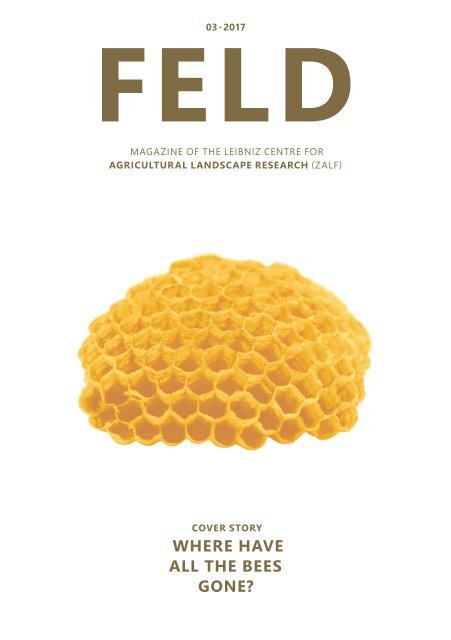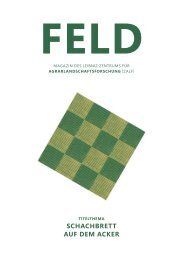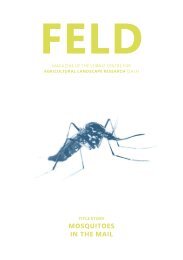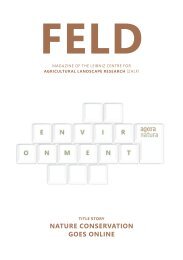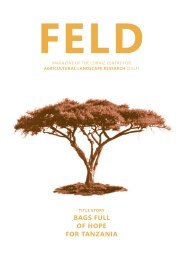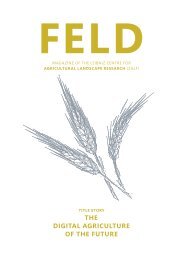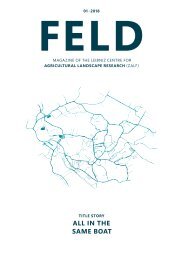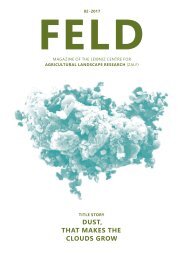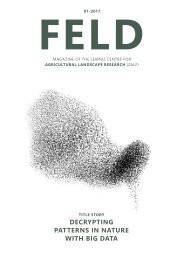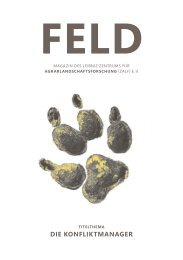FELD 03/2017
Without them there would be no apples, no tomatoes, no strawberries: However, there are fewer and fewer pollinators like bumblebees and bees buzzing around. In their search for the causes, researchers are taking a closer look at the ecosystem of arable land. // Millions of people live in big cities. The food they eat, usually has to be transported over hundreds of kilometres. A study is now investigating which metropolitan areas could organize their food supply more regionally. // Most of the fens in Germany have dried up and can no longer fulfil important environmental functions. A pilot project in Brandenburg has now for the first time tested their rewetting using purified waste water from sewage treatment plants. // Invasive mosquito species are on the rise in Germany: With the aid of a computer model, researchers want to predict their future distribution.
Without them there would be no apples, no tomatoes, no strawberries: However, there are fewer and fewer pollinators like bumblebees and bees buzzing around. In their search for the causes, researchers are taking a closer look at the ecosystem of arable land. //
Millions of people live in big cities. The food they eat, usually has to be transported over hundreds of kilometres. A study is now investigating which metropolitan areas could organize their food supply more regionally. //
Most of the fens in Germany have dried up and can no longer fulfil important environmental functions. A pilot project in Brandenburg has now for the first time tested their rewetting using purified waste water from sewage treatment plants. //
Invasive mosquito species are on the rise in Germany: With the aid of a computer model, researchers want to predict their future distribution.
You also want an ePaper? Increase the reach of your titles
YUMPU automatically turns print PDFs into web optimized ePapers that Google loves.
<strong>03</strong> · <strong>2017</strong><br />
MAGAZINE OF THE LEIBNIZ CENTRE FOR<br />
AGRICULTURAL LANDSCAPE RESEARCH (ZALF)<br />
COVER STORY<br />
WHERE HAVE<br />
ALL THE BEES<br />
GONE?
SUSTAINABLE DEVELOPMENT GOALS<br />
CONTENTS<br />
17 »Sustainable Development Goals« are the centerpiece of the Agenda 2<strong>03</strong>0,<br />
approved in 2015 by the United Nations (UN). The Agenda lays a foundation for<br />
global economic development in accordance with social justice and within the<br />
ecological boundaries of planet earth.<br />
MORE INFO<br />
https://sustainabledevelopment.un.org/sdgs<br />
Without them there would be no apples, no tomatoes,<br />
no strawberries: However, there are FEWER AND FEWER<br />
POLLINATORS LIKE BUMBLEBEES AND BEES buzzing around.<br />
In their search for the causes, researchers are taking a<br />
closer look at the ecosystem of arable land.<br />
02<br />
The research projects presented in this issue address the following<br />
Sustainable Development Goals:<br />
Millions of people live in big cities. The food they eat,<br />
usually has to be transported over hundreds of kilometres.<br />
A study is now investigating which METROPOLITAN<br />
AREAS could organize their FOOD SUPPLY MORE REGIONALLY.<br />
10<br />
2 3 6 9<br />
NO FAMINE<br />
SUSTAINABLE<br />
CONSUMPTION AND<br />
PRODUCTION<br />
GOOD HEALTH CARE<br />
CLIMATE PROTECTION<br />
MEASURES<br />
CLEAN WATER AND<br />
SANITARY FACILITIES<br />
12 13 14 15<br />
LIVING IN WATER<br />
INDUSTRY,<br />
INNOVATION AND<br />
INFRASTRUCTURE<br />
LIVING ON LAND<br />
Most of the fens in Germany have dried up and can<br />
no longer fulfil important environmental functions.<br />
A pilot project in Brandenburg has now for the first<br />
time tested their REWETTING USING PURIFIED WASTE<br />
WATER from sewage treatment plants.<br />
INVASIVE MOSQUITO SPECIES are on the rise in Germany:<br />
With the aid of a COMPUTER MODEL, researchers want to<br />
predict their future distribution.<br />
20<br />
30<br />
INTERVIEW 28 · NEWS 34 · LEGAL NOTICE 36<br />
01
COVER STORY<br />
WHERE HAVE<br />
ALL THE BEES<br />
GONE?<br />
Insects are essential for many plants in our fields and plantations.<br />
Alongside the honey bee, a whole armada of wild insects makes<br />
sure that flowers are pollinated and produce fruit. However, the<br />
colonies under the care of beekeepers as well as their wild<br />
relatives are falling in numbers. Fewer and fewer bumblebees, bees<br />
and hoverflies are humming in the fruit trees and buzzing across<br />
the fields. While looking for the causes, it was discovered that no<br />
blanket solutions exist, and that it is worth taking a closer look at<br />
the ecosystems of arable lands and their surroundings.<br />
02<br />
<strong>03</strong>
Pollinators<br />
Pollinators<br />
235 to 577 billion US dollars: That is the value of the service that pollinators<br />
such as honey bees, wild bees, butterflies, bats and birds provide worldwide<br />
every year. They transport the pollen from one flower to another and they do<br />
it free of charge. There's just one catch: the number of flower pollinators has<br />
declined rapidly in recent years. Many species are endangered, threatened<br />
with extinction or already irretrievably lost. This is not only a cause of concern<br />
for environmental protection and science. Some of our crops produce either<br />
considerably less or no fruit without these flower visitors. If the pollinators die,<br />
food security is also at risk.<br />
The urgency of the problem is already evident today, in regions where<br />
there are hardly any wild flower visitors: in some regions of Asia, people pollinate<br />
the flowers in the orchards with brushes. In Japan and the USA, mini<br />
drones are developed to do the job instead. How can research help to save the<br />
pollinators before it is too late?<br />
A team from the Leibniz Centre for Agricultural Landscape Research<br />
(ZALF) and the Johann Heinrich von Thünen Institute have embarked on a<br />
search for answers. "There are many different causes", Karoline Brandt explains.<br />
"The interrelationships between the organisms, their environment, the areas<br />
under cultivation and the type of cultivation are complex." But the list of the<br />
threats is long. Whether monocultures, destroyed natural habitats or pesticides<br />
– in intensified agriculture, insects find less and less food and fewer basic living<br />
conditions. Their populations are weakened, making them more susceptible to<br />
disease and parasites. Brandt says, however, that it is difficult to precisely quantify<br />
individual causes or make precise statements about their interactions. Up to<br />
now, individual influencing factors have been examined separately from each<br />
other – with partly contradictory research results.<br />
WITH ATTENTION TO DETAIL<br />
To remedy this situation, the researcher and her team spent three years investigating<br />
fields in Mecklenburg-Western Pomerania, Thuringia and Bavaria. They<br />
questioned how well suited these are as habitats for Bumblebees and Co. They<br />
selected three farms, two conventional and one organic, with 15 fields each for<br />
their survey . First of all, they had to determine which pollinator species occur<br />
on the fields and in what numbers.<br />
From April to October, insect traps were set up and inspected every two<br />
weeks. In total Brandt and her team identified 157 species. The 23 most common,<br />
which belonged to six different groups of insects, were analysed in more detail.<br />
Using special traps in signal colors, which look like flowers to bees, the pollinators are<br />
captured to be counted and then identified on the fields<br />
At the same time, they recorded which crops were growing at a given time, how<br />
high the plants were, how much soil they covered and which wild herbs were<br />
present. In addition, they also took a closer look at the surrounding area within<br />
a radius of one kilometer: Were the neighbouring areas also farmed? Were there<br />
any settlements nearby? How high was the proportion of forest, grassland or<br />
semi-natural shrubbery, hedges and fallow land?<br />
The results show which living conditions have a positive effect on these<br />
pollinating insects and the scope of action available to agriculture to support them.<br />
04 05
Pollinators<br />
Pollinators<br />
The challenge is to protect as many different species of pollinators as possible,<br />
taking into account their individual needs, because this is the only way to ensure<br />
that the required pollination performance is sustained. For example, the role of<br />
wild bees has so far been underestimated. Recent studies show: These highly efficient<br />
pollinators, do not usually live in colonies but solitary, pollinate crops twice<br />
as effectively as honey bees, also fly at low temperatures and visit more flowers.<br />
Particularly for those insects that still require an abundant supply of<br />
food in late summer and autumn, survival in agricultural landscapes is usually<br />
difficult. "The problem is often the so-called food gaps", Brandt explains. Rapeseed<br />
monocultures, for example, provide nectar and pollen in abundance for<br />
three to five weeks in early summer. Once the rapeseed has flowered, however,<br />
Many bumblebee colonies nest in hollow spaces close to the ground, which they<br />
find in rotten wood, in the moss layer or in old nests of mice.<br />
More diversified<br />
crop rotations in the<br />
fields can close<br />
food gaps.<br />
DIFFERENT BEES, DIFFERENT REQUIREMENTS<br />
So far, the results show above all one thing: hoverflies, honey bees, bumblebees,<br />
but also the lesser-known sweat bees, mining bees or mason bees – they all are<br />
frequent and important guests in the areas observed. However, their demands on<br />
food sources and nesting possibilities vary greatly. Whereas mining bees require<br />
a dry place with loose soil for example, some types of bumblebees require cavities<br />
close to the ground for their nests. Many species of mining bees are only<br />
active as flying insects in spring and accordingly need food in the form of pollen<br />
and nectar. In the case of the hoverfly, it is the other way round, as it does not<br />
start its high season until August. Bumblebee colonies, on the other hand, are<br />
on the wing from spring to autumn – and correspondingly hungry. "We need<br />
to take the differences in lifestyles between the individual groups into account.<br />
It cannot be said in general terms that this or that measure is good for flower<br />
visitors", explains Brandt, summarising the results. Before implementing conservation<br />
measures in an area, it is important to find out which pollinating insects<br />
are found there under natural conditions in order to specifically promote these.<br />
"There is no single solution for everything."<br />
KAROLINE BRANDT<br />
the pollinating insects are facing lean times. If there is a beekeeper on site, he<br />
or she will take the bee colonies to more prolific feeding grounds. However, this<br />
shuttle service is not available to wild insects. Only wild herbs blooming on field<br />
margins or other flowering crop plants save them from starvation.<br />
Extended crop rotations, which provide a variety of food over a long<br />
period of time, offer alternatives. Instead of relying on the same crop plants such<br />
as maize or wheat, for example, clover, legumes or new energy crops like the<br />
cup plant, could be integrated into the crop rotation as an attractive additional<br />
source of nectar and pollen. Flower strips of wild herbs that bloom throughout<br />
the year can also close the food gap in critical periods.<br />
A further reason for the long-standing dramatic decline in insect populations<br />
is not only the lack of basic food resources, but also a frequently used<br />
group of insecticides: Neonicotinoids, which are highly effective and attack the<br />
06 07
Pollinators<br />
Pollinators<br />
EXISTENTIAL FOR AGRICULTURE<br />
If we want<br />
to protect<br />
pollinators,<br />
we must<br />
preserve the<br />
diversity of<br />
the landscape.<br />
An intact pollinator system is not only existential for consumers, but also for<br />
agriculture. "Many people are aware of how important the performance of bees<br />
and bumblebees is for their crop plants" Brandt says. "But they often shy away<br />
from the strict EU directives when it comes to concrete action." In order to<br />
obtain funds for the loss of yield, a flower strip on the edge of the field, which<br />
provides insects with food and habitat for their entire lifespan, must be sown<br />
at a precisely defined time and with a precisely specified width. If the farmer<br />
deviates from the guidelines, he can expect significant financial losses. And the<br />
bureaucratic requirements for farmers are often so high that they would rather<br />
continue as before. Brandt would like to see more flexibility and pragmatism<br />
from politicians in order to facilitate the transition to insect-friendly agriculture.<br />
Results show: there is no one right answer. Every environment has its<br />
own pollinator community that needs protection. Using the data obtained,<br />
the researchers are hoping to use ecological models to predict how the insect<br />
community will develop in the future, depending on the crop grown and the<br />
landscape features. One thing is certain for Brandt: "If we want to maintain the<br />
pollinators' performance, we need to preserve the biodiversity of the landscape<br />
as well as the crop species and understand their interrelationships."<br />
KAROLINE BRANDT<br />
insects' nerve cells, are absorbed by the plants and degrade very slowly. The crop<br />
plants are indeed protected against pests, but the active ingredient also finds its<br />
way into pollen and nectar. Laboratory studies have shown its harmful effects<br />
on pollinating insects. Under field conditions, the research results to date are<br />
not conclusive, as there is still too little data available.<br />
KAROLINE BRANDT<br />
is a Geography graduate. After her studies<br />
at the Humboldt-University of Berlin, she<br />
started researching different groups of<br />
organisms in agricultural landscapes at the<br />
Institute for Land Use Systems at ZALF in<br />
2011. Today, she works at the Thünen Institute<br />
for Biodiversity in Braunschweig.<br />
www.zalf.de/feld/en<br />
08 09
HUNGER<br />
IN THE CITY<br />
Life is booming in the city. Millions of people live and work here.<br />
And they eat. But where do the tons of food come from that are<br />
consumed day after day? Usually, milk, bread or vegetables are<br />
transported hundreds of kilometers on highways from north to<br />
south and from east to west. But is that really necessary? The urban<br />
planner and agronomist Ingo Zasada has investigated whether the<br />
metropolitan regions of Europe could supply their inhabitants with<br />
more regional food.<br />
10<br />
11
Regional food supply<br />
Regional food supply<br />
Once upon a time there was a strawberry. It grew into a sweet fruit on a strawberry<br />
bed in Poland. One morning it was harvested, packed into a crate and<br />
loaded onto a truck with many other red strawberries. The journey was long –<br />
the fruit travelled for 800 kilometers before it was unloaded in Aachen where<br />
it was processed into fruit pulp. But that was not the end of the journey. The<br />
crushed berry was bottled, reloaded and travelled another 450 kilometers to<br />
Stuttgart. Here the pulp was put in jars. Following a final trip of just under 700<br />
kilometers, the strawberry finally arrived as yoghurt on a supermarket shelf in<br />
Hamburg. Total distance travelled: almost 1950 kilometers.<br />
Whether it is strawberries, pork steaks or apple juice – our food rarely<br />
comes from the nearest farm. "We have a globalized food supply system", says<br />
Ingo Zasada of the Leibniz Centre for Agricultural Landscape Research (ZALF).<br />
"Only a fraction of the food we consume comes from the region we live in." And<br />
yet the transport of our food over such long distances consumes large quantities<br />
of natural resources and boosts climate change. At the same time, consumers<br />
are becoming increasingly dependent on global markets.<br />
So there are good reasons to produce food in the places where it is consumed.<br />
But is it possible? Can people in big cities provide themselves to a larger<br />
extent with food grown and produced in their own neighborhood?<br />
This is exactly what Zasada wanted to find out. He investigated four different<br />
metropolitan regions in Europe as part of the EU-funded "FOODMETRES"<br />
project together with researchers from Great Britain, Italy and the Netherlands.<br />
How much agricultural land is required to feed Berlin, Milan, Rotterdam<br />
or London? Now and in 2050, when there will be even more people living<br />
in Europe's major cities?<br />
EVERY TASTE HAS ITS PRICE<br />
In order to answer these initial questions, the scientist first examined the eating<br />
habits in the cities. To this end, he drew up national statistics on the consumption<br />
of milk, meat and vegetables and determined the area needed to cover each<br />
person's nutritional requirements. Data on the respective agricultural production,<br />
the yield of which is dependent on climate, soil and other environmental<br />
factors, were included in the calculations, as were quotas for food products that<br />
cannot be produced in Europe – such as tea or chocolate.<br />
The result: the populations in the cities surveyed eat an average of about<br />
1000 kilograms of food per capita and year. In Berlin, 2052 square meters of<br />
Long transport routes and their associated consumption<br />
of resources are a consequence of the globalized<br />
food system. Food production and consumption are<br />
spatially separated.<br />
12 13
Regional food supply<br />
Regional food supply<br />
It's easier to throw food<br />
away when you no longer<br />
have any perception of its<br />
origin.<br />
INGO ZASADA<br />
land are needed for food production, 1862 in London, 2093 in Milan and 1718<br />
in Rotterdam. The reason for the variations are the different eating habits in<br />
these European metropolitan areas.<br />
Zasada then took a closer look at the areas around the cities and determined<br />
how much agricultural land there could actually be used. The figures show<br />
that Berliners in particular should not have any problems meeting their nutritional<br />
needs with regional products. The surrounding area is sparsely populated<br />
and characterized by agriculture. There are 14600 square kilometers of arable<br />
land and grassland within a radius of about 110 kilometers. The German capital<br />
needs only about 7300 in order to cover its entire supply with regional products.<br />
Berlin is the big exception, though. In all the other cities surveyed, there<br />
is not enough agricultural land in the surrounding area to produce sufficient<br />
food. The outskirts of the cities are too densely populated, the soils are not fertile<br />
enough and the arable land available is limited by mountains or the sea. The<br />
problem is likely to intensify in the foreseeable future when more people live<br />
in the regions studied.<br />
ONE'S OWN CONTRIBUTION<br />
Nevertheless, Zasada is optimistic: "Self-sufficiency is difficult, but is at least<br />
partially achievable." Consumer behaviour is an important factor in this respect.<br />
17 percent of all food is lost through the production and retail chain, another<br />
14 percent is lost in households. The area required could be drastically reduced<br />
if less food ended up in the waste bin.<br />
Zasada sees one reason for the wastage in the large gap that exists between<br />
consumption and production. Many people no longer know where the potato or<br />
the steak on their plates comes from, how these are cultivated or processed. The<br />
famous purple cows, frequently painted by German children who have never<br />
been to a real farm, are a symptom of this gap. The consequence: It is easier to<br />
throw food away when you no longer have a relationship to its origin.<br />
THE FIRST STEP<br />
Nutrition and food production currently have hardly any role to play in city<br />
councils and municipalities. However, the researcher is convinced that these<br />
questions will gradually come to the forefront again. The first signs of change<br />
are the urban populations themselves: mobile gardens are being built in crates<br />
14 15
Regional food supply<br />
Regional food supply<br />
on derelict land, roofs are being transformed into gardens and balconies into<br />
snack bars. "Urban gardening is a trend that encompasses many aspects", says<br />
Zasada. It is not only about healthy organic food that is grown locally, but also<br />
about social participation in the city, knowledge of gardening, education and<br />
integration. Nevertheless, the gardens on roof terraces or in backyards are not<br />
highly productive agricultural farms. They will not be able to provide enough<br />
food for the big cities. This is where initiatives such as the Nutrition Council of<br />
Berlin come in. They actively introduce a holistic view on food production into<br />
the everyday political life of the city.<br />
These initiatives, as well as associations, authorities and politicians, have now<br />
been provided with reliable scientific data thanks to the work of Zasada and his<br />
research partners. The scientist calls for a pragmatic approach to his research<br />
results. They are not a plea for the complete self-sufficiency of large cities, which<br />
is not always efficient: "We are more interested in raising awareness of how we<br />
can transform these processes sustainably through our own daily behavior as<br />
consumers." It is therefore worthwhile examining which parts of agriculture<br />
could be regionalised. According to the data, we certainly have the potential<br />
to do this in Berlin.<br />
Our own<br />
behavior as<br />
consumers is an<br />
important factor.<br />
INGO ZASADA<br />
Urban Gardening projects are an expression of social<br />
rethinking, but can only be part of the solution that leads<br />
to a sustainable food system.<br />
www.zalf.de/feld/en<br />
16 17
Regional food supply<br />
Regional food supply<br />
FACTS & FIGURES<br />
Average food consumption in Berlin<br />
Production area required to cover<br />
food consumption<br />
Other food<br />
29<br />
Meat + Fish<br />
99<br />
Other food<br />
134<br />
Luxury food<br />
178<br />
Luxury food<br />
255<br />
Meat + Fish<br />
677<br />
Cereals<br />
132<br />
kg/year<br />
per person<br />
Dairy products + Eggs<br />
355<br />
Cereals<br />
244<br />
m 2<br />
per person<br />
Fruit + Vegetables<br />
259<br />
Fruit + Vegetables<br />
126<br />
Dairy products + Eggs<br />
616<br />
Source: Zasada et al. (<strong>2017</strong>)<br />
18<br />
19
SAVING FENS<br />
WITH WASTE WATER<br />
Intact fens are usually very old and several meters thick. They provide<br />
habitats for rare animal and plant species and store enormous<br />
amounts of water and carbon in their peat layer. However the overwhelming<br />
majority of fens in Germany have dried up and can no<br />
longer fulfil these functions. Scientists have now tested the rewetting<br />
of a lowland fen in the Uckermark region using an unusual<br />
resource: purified waste water from sewage treatment plants.<br />
20<br />
21
Rewetting of fens<br />
Rewetting of fens<br />
All around grassland and fields, as far as the eye can see, with some small villages<br />
and forests in between: from a bird's-eye view, in the middle of the landscape, a<br />
rectangular area covered with reeds becomes visible. Ditches and two small ponds<br />
border the area which covers around ten hectares. It is the remainder of a once<br />
intact lowland fen in Brandenburg. At some point, drainage ditches were dug<br />
around it in order to lower the groundwater level and cultivate the surrounding<br />
areas. The water was drained out of the lowland fen. It has been drying out for<br />
decades. In the 1990s, the area attracted the attention of researchers and a test<br />
area was established – also to test the subsequent use of such dehydrated fens.<br />
In 2011, the federally funded "ELaN" project was launched, through which<br />
researchers from the Leibniz Centre for Agricultural Landscape Research (ZALF)<br />
saw an opportunity to revive the fen with an unusual idea: Purified waste water<br />
from a nearby sewage treatment plant was to be used to return the necessary<br />
moisture to the habitat and stabilize the hydrological balance.<br />
SUCH A WASTE OF WASTE WATER<br />
"Water from sewage treatment plants is usually channelled into ditches or<br />
rivers in order to get it out of the landscape as quickly as possible. This is to prevent<br />
it from seeping into the soil and contaminating the groundwater", says Dr.<br />
Sebastian Maassen from ZALF. Because when it comes from the sewage treatment<br />
plant, it still contains numerous residual pollutants and nutrients, which<br />
now flow through the rivers into the seas. Instead, this water could be used<br />
more intelligently. "You could reach two goals at once: irrigate the dehydrated<br />
fens and at the same time clean the waste water more thoroughly." This also<br />
applies to the waste water from the nearby sewage treatment plant in Passow.<br />
Analyses have identified at least 67 micro-pollutants – primarily residues from<br />
medicines or personal care products. "The trace elements tell us a lot about the<br />
social structure of the region", says Maassen. In Berlin, for example, there are<br />
more residues of birth control pills, whereas here in the Uckermark there are<br />
more painkillers and sweeteners. The researchers also found corrosive agents<br />
or x-ray contrast media in the waste water in Passow. None of these substances<br />
should be allowed to find their way into groundwater. Now it was time to find<br />
out whether the fen prevented this from happening.<br />
The lowland fen in the Uckermark was an ideal experimental area. "The<br />
dried out fen may no longer be intact, but it still contains a lot of organic matter,"<br />
explains Maassen. This creates favorable conditions for the decomposition<br />
of a great many residues. Another factor is that the water can remain there for<br />
A measuring station for the groundwater level and water temperature is well<br />
hidden between the reeds. It records the share of diluted waste water found<br />
in the total soil water of the fen.<br />
22 23
Rewetting of fens<br />
Rewetting of fens<br />
a long time before it reaches the surrounding ditches and the groundwater. In<br />
addition, many micro-organisms live in the fen which also remove substances<br />
from the waste water. For the pilot project, Maassen and his team diluted the<br />
waste water from the Passow sewage treatment plant with ten times the amount of<br />
surface water in order to control the rewetting of the fen over a three-year period<br />
under strict conditions. The constituent substances in the waste water, soil and<br />
groundwater of the experimental area were constantly monitored and analysed.<br />
The results speak for themselves: "In the waste water from our sewage<br />
treatment plant, we were able to detect numerous undesirable substances that<br />
had subsequently disappeared in the groundwater of our test site, i.e. after the<br />
'cleansing' by the fen", said Maassen. The fen apparently "swallowed and digested"<br />
the substances. It is not yet possible to describe exactly which processes are<br />
responsible for this. Micro-organisms, plants or sunlight – the influences of the<br />
individual decomposition processes are manifold. However, some residues are<br />
also bound into the peat or fen soil. So-called toxicity tests with plants, bacteria,<br />
annelids and other organisms gave cause for optimism: They did not reveal any<br />
negative effects of the treated waste water on soil life.<br />
You can kill two birds<br />
with one stone: irrigate<br />
the dehydrated fens and<br />
at the same time clean<br />
the waste water more<br />
thoroughly.<br />
DR. SEBASTIAN MAAßEN<br />
One option for the management of lowland fen sites is to keep water buffaloes<br />
(left). On the Elan project's experimental area, however, paludicultures, in particular<br />
the cultivation of reeds, is to be tested (right).<br />
24 25
Rewetting of fens<br />
Rewetting of fens<br />
ON DRY LAND<br />
From an ecological viewpoint, there seems to be no reason not to rewet fens<br />
using purified waste water from sewage treatment plants. Further research is<br />
required however. But since 2015, the pilot site has been left high and dry again,<br />
because of a shortage of financing for the pumps. There is hope, however: "The<br />
Michael Succow Foundation would like to test the cultivation of renewable raw<br />
materials", says Maassen. For if intact fenland was once considered economically<br />
unviable due to the high groundwater levels, ideas for sustainable use<br />
certainly exist today. Reeds can be grown here for example, which can be used<br />
as biomass for energy production. Water buffaloes find excellent conditions on<br />
the sites, as do black alder trees, which provide valuable wood.<br />
"The topic will become increasingly important in the future", of this Maassen<br />
is certain. Because in many areas throughout Germany – especially in the<br />
northeast – water is already a scarce resource. Predominantly sandy soils allow<br />
it to seep away quickly and land management has so far paid little attention to<br />
the storage of water resources. Climate change will further intensify the problem.<br />
The establishment of closed water cycles could help to preserve natural water<br />
reservoirs and valuable habitats such as the fen in the Uckermark.<br />
Trace elements in<br />
waste water reveal a<br />
lot about the regional<br />
population.<br />
DR. SEBASTIAN MAAßEN<br />
www.zalf.de/feld/en<br />
26 27
Interview<br />
WOMEN IN THE<br />
NATURAL SCIENCES<br />
Ms. Bellingrath-Kimura, you were invited as<br />
a speaker to this year’s Gender Summit 10 in<br />
Tokyo to report on gender equality in scientific<br />
professions in Germany. How equal are<br />
things here in Germany?<br />
Also in Germany there are fewer women than<br />
men studying for a profession in the natural<br />
sciences, which of course has a lot to do with<br />
social role models. Physics, chemistry, technology<br />
etc. are more likely to be seen as male domains.<br />
This is a picture that is also imprinted in<br />
the minds of women. According to a study carried<br />
out in 2015, almost 30% of young women<br />
who were very good at mathematics in school<br />
still choose to study languages, culture, sport or<br />
art. The figure for boys is just below 10%. When<br />
girls go into the sciences, they tend to go into<br />
medicine or biology.<br />
How should we deal with this?<br />
We have to address young girls in school education<br />
more intensively about the topics that<br />
are relevant to them and encourage them to<br />
become enthusiastic about science. For example,<br />
they are much more interested in mental<br />
and physical well-being than boys and less so<br />
in technology. Of course, we can now discuss to<br />
what extent this has to do with adopted prejudices,<br />
but I think it is more efficient to accept<br />
these differences and to work with them.<br />
You became a mother yourself in July 2016.<br />
How do you manage to reconcile your family<br />
with your position as director of an institute?<br />
To state it quite clearly: you cannot do it alone.<br />
It is important to have a good team around me<br />
in my job, to which I can hand over tasks and<br />
responsibilities. And at times when I have to<br />
be present on site as a decision-maker, you will<br />
also find me with a child on my arm. Of course,<br />
to do so requires an environment that accepts<br />
this. We must however also strengthen men in<br />
their roles as fathers. My experience is that as<br />
soon as paternal commitment goes beyond the<br />
occasional sick leave, men at work are chastised<br />
even more than women. Which only makes<br />
it clearer that childcare is often still seen as a<br />
woman’s job.<br />
What more can we do to close the gender<br />
gap in the natural sciences?<br />
Mentoring programs to help women better<br />
identify career ladder structures are definitely<br />
useful. The discussion of a women’s quota also<br />
helps, as it encourages a new way of thinking.<br />
In the meantime, I often observe that consideration<br />
is given to a genuinely balanced<br />
relationship between the genders before any<br />
quota is even brought into play.<br />
Tackling the Gender Gap<br />
What about the working conditions in the<br />
scientific professions themselves?<br />
Unfortunately, the same also applies here: the<br />
higher you look up the career ladder, the lower<br />
the proportion of women. According to a survey<br />
among professors in leading positions, the<br />
reasons for this are perceived differently. Both<br />
women and men saw the reconciliation of work<br />
and family life as a major obstacle. But significantly<br />
more women also consider covert discrimination<br />
and the formation of male social<br />
networks to be equally solid reasons. The latter<br />
especially when women are limited in time and<br />
place of work.<br />
PROF. DR. SONOKO DOROTHEA<br />
BELLINGRATH-KIMURA<br />
is Head of the Institute for Land Use Systems at<br />
ZALF since April 2015. Her fields of expertise are<br />
plant production, soil science and agricultural<br />
sciences. As a mentor she is also specifically<br />
involved in the promotion of young female<br />
scientists.<br />
28<br />
29
Mückenmodell<br />
THE VIRTUAL PATH<br />
OF THE MOSQUITO<br />
There are more than 3500 different species of mosquitoes in the world, about 50 of<br />
which are native to Germany. Their numbers are likely to increase in the future,<br />
as new species such as the Asian bush mosquito are joining the common house<br />
mosquito. The great question: How will these new, exotic species establish themselves<br />
and spread geographically? Will they remain permanently in Germany?<br />
Answers are difficult to find. Not only is it necessary to know exactly the<br />
needs of the individual mosquito species, but also the conditions under which<br />
they produce offspring or into which areas they prefer to migrate.<br />
Dr. Ralf Wieland from the Leibniz Centre for Agricultural Landscape<br />
Research (ZALF) is a computer scientist. Using a computer model, he hopes to<br />
predict the future distribution of mosquito populations. He is using the database<br />
of the mosquito atlas research project which was launched by ZALF and<br />
the Friedrich Loeffler Institute (FLI) as his basis. The proliferation of mosquitoes<br />
in Germany has been mapped since 2012 with the help of normal citizens<br />
sending in mosqitoes they caught in their neighborhood and observations by<br />
the scientists themselves. Dr. Wieland's model links this huge data pool with<br />
a total of 37 weather variables including rainfall, monthly temperatures, frost<br />
days or a drought index.<br />
The amount of data is enormous and can only be handled with high<br />
computing power and storage capacity. More than 137 billion simulation steps<br />
would have to be carried out, taking at least one second each – amounting to<br />
a total computing time of around 4000 years. "But of course no one can wait<br />
that long", says Dr. Wieland. Even the computer cluster at ZALF would require<br />
more than 34 years to complete all the calculations.<br />
THE EVOLUTION IN THE COMPUTER<br />
They come to Europe using a wide variety of routes and transports:<br />
invasive mosquito species are on the rise, not only in Germany. They<br />
are successfully populating new areas, also because climate change<br />
provides them with more favorable living conditions. Researchers<br />
have been recording these developments since 2012 in the Mosquito<br />
Atlas project. With the aid of mathematical models, they are now<br />
going one step further and are making computer-aided predictions<br />
about their future distribution.<br />
Yet Dr. Wieland solved the problem with a method he has called the "Genetic<br />
Optimization Algorithm". In a similar way to nature, the model goes through<br />
a kind of evolution in which certain promising factors prevail, while others are<br />
discarded. This training gradually reduces the computational effort required.<br />
At the end of the day, the model has learned to distinguish between important<br />
and unimportant factors. Thus, it emerged that only eight weather variables<br />
are critical for mosquitoes, including the rainfall in spring or the temperatures<br />
in early summer.<br />
The figures from the computer model are constantly compared with the<br />
current mapping results of the mosquito atlas. This showed how quickly the<br />
simulation came impressively close to reality. Based on the data from 2012-2015<br />
30<br />
31
Mückenmodell<br />
Mückenmodell<br />
UNTIL 2020<br />
UNTIL 2080<br />
for example, the model calculated that the Asian bush mosquito would settle in<br />
the vicinity of Jena in Thuringia in 2016: a forecast that was accurately confirmed.<br />
With each new mosquito finding, the computer model becomes more reliable<br />
and provides the mosquito atlas team with increasingly accurate information<br />
about potential distribution areas. "We send tens of thousands of virtual mosquitoes<br />
on their travels and track each and every path", Dr. Wieland explains.<br />
He and his team continue to work on refinements to the model. Climate<br />
change will be taken into account in the future, as will characteristic landscape<br />
features or human intervention. What obstacles do the mosquitoes have to overcome?<br />
Which routes encourage their distribution? For example, the mosquito<br />
atlas team discovered that the new habitats of the Asian tiger mosquito are almost<br />
always found along motorways – yet another variable to be added to the model.<br />
The results can ultimately be used to create distribution maps for the<br />
future. The model is already simulating the conditions under which the Asian<br />
bush mosquito could settle in Germany: "It will establish itself throughout<br />
West Germany, including Thuringia, parts of Mecklenburg-Western Pomerania<br />
and Lower Saxony. In principle throughout the whole of Germany by 2060."<br />
Thus, the future path of the mosquitoes has already been virtually mapped out,<br />
thereby providing mosquito researchers with important clues and ideas for their<br />
search in the real world.<br />
Dr. Wieland is not only able to use his model for mosquitoes, it would<br />
work just as well for other animals. "We are in the middle of a great revolution<br />
in science", he stresses. Of course, individual researchers are not about to be<br />
replaced by machines. "But computers today allows us data-supported insights<br />
into interrelationship that were simply not possible just a few years ago due to<br />
the lack of computing power."<br />
Areas in which the Asian bush mosquito has at<br />
least a 50% chance of occuring.<br />
www.zalf.de/feld/en<br />
32<br />
33
News<br />
News<br />
ACROSS THE FIELD<br />
EVENT: OUTLOOK<br />
LANDSCAPE 2018<br />
EVENT: REVIEW<br />
25 YEARS OF ZALF<br />
Climate Change, Food Security, Sustainable Agriculture:<br />
The interplay between natural processes, land<br />
use and social developments is the focus of "LAND-<br />
SCAPE 2018 – Frontiers of Agricultural Landscape<br />
Research", the international conference organised by<br />
ZALF, which will take place from 12 to 16 March 2018<br />
in Berlin. The objective of the conference is to facilitate<br />
the exchange between science, practice and other social<br />
interest groups in order to work together on solutions<br />
for the agriculture of tomorrow. All those interested<br />
can register by 28 February 2018 at www.land2018.eu.<br />
RESEARCH<br />
LANDSCAPE GENETICS OF<br />
FOREST HERBS<br />
Starting in February 2018, researchers at ZALF and<br />
the Senckenberg Entomological Institute (SDEI) will<br />
spend three years investigating how the propagation of<br />
forest herbs functions between forest fragments in the<br />
agricultural landscape that are not spatially connected<br />
by their root system. The DFG-funded project focuses<br />
on the role of various insect species and the distances<br />
they cover when pollinating plants. In this context, it<br />
is also interesting to examine the role of the so-called<br />
landscape matrix, i.e. the agricultural area between<br />
the spatially separated forest patches.<br />
In <strong>2017</strong>, the Leibniz Centre for Agricultural Landscape<br />
Research (ZALF) celebrated its 25th anniversary. In<br />
the summer, a scientific symposium with around 250<br />
guests from science, politics and practice was held on<br />
the Muencheberg Campus. Projects, laboratories and<br />
technology were presented during a tour of the campus.<br />
In the afternoon, companions, sponsors and partners,<br />
along with the ZALF Executive Board and their guests,<br />
reviewed the history during a festive ceremony in<br />
ZALF's own greenhouses and looked forward together<br />
to the future of the research facility. A few days later,<br />
the Open Day also celebrated 25 years of agricultural<br />
landscape research.<br />
BEST PRACTICE<br />
RESOLVING AND AVOIDING<br />
CONFLICTS IN LARGE-SCALE<br />
RESEARCH PROJECTS<br />
Within the framework of the Trans-SEC project on<br />
food security, a co-operation between ZALF and the<br />
Institute for Conflict Management at the European<br />
University Viadrina in Frankfurt (Oder), a guideline<br />
for co-operation in large-scale collaborative<br />
projects was developed. Its aim is to structure modern<br />
interdisciplinary research in a constructive and<br />
solution-oriented manner despite the different backgrounds<br />
and approaches of the actors involved. The<br />
brochure is aimed at scientists and practitioners of all<br />
disciplines and is available to download free of charge at<br />
www.zalf.de in German and English.<br />
LEIBNIZ<br />
DOCTORAL STUDENTS<br />
NETWORK: MEIKE WELTIN<br />
SPOKESWOMAN SECTION E<br />
In September <strong>2017</strong>, Meike Weltin, researcher at the<br />
Institute of Socioeconomics at ZALF, was elected as new<br />
spokeswoman for the Environmental Sciences Section<br />
of the Leibniz PhD Network. Since its foundation in<br />
September 2016, the network has been committed to<br />
improving the exchange of information between doctoral<br />
students and represents their interests within the<br />
Leibniz Association.<br />
www.zalf.de/de/aktuelles/<br />
34<br />
35
The mission of the Leibniz Centre for Agricultural Landscape Research (ZALF)<br />
is to explain causal relationships in agricultural landscapes and to provide<br />
society with sound information for the sustainable use of these landscapes<br />
through excellent interdisciplinary research. The research expertise is focused<br />
on three core topics.<br />
LANDSCAPE FUNCTIONING<br />
The focus of Core Topic I »Landscape Functioning« lies on studying<br />
natural-scientific basics in order to improve the understanding of relevant<br />
processes and interdependencies on the landscape scale.<br />
Leibniz Centre for Agricultural<br />
Landscape Research (ZALF)<br />
Eberswalder Strasse 84<br />
D-15374 Müncheberg<br />
T +49 (0) 33432 82200<br />
F +49 (0) 33432 82223<br />
Executive Board<br />
Prof. Dr. Frank Ewert<br />
(Scientific Director)<br />
Cornelia Rosenberg<br />
(Administrative Director)<br />
Photo Credits<br />
Title: SyB / Fotolia; p. 2: Carola Vahldiek / Fotolia;<br />
p. 5,8: Cornelia Fischer / ZALF; p. 6: Alchemilla /<br />
Pixabay; p. 9: Michael Welling / Thünen-Institut;<br />
p. 10: Tupungato / iStock; p. 12: maradon 333 /<br />
Shutterstock; p. 14: Eivaisla / iStock; p. 16: Regine<br />
Berges / ZALF; p. 20: abadonian / iStock; p. 23,<br />
25: Dagmar Balla / ZALF; p. 24: Manuel Krug /<br />
manuelkrug.de; p. 26: view7 / Photocase; p. 28, 35<br />
bottom: Hendrik Schneider / ZALF; p. 30: Doreen<br />
Walther / ZALF; p. 32: Hannes Schulze / Nur Mut;<br />
p. 34 top, 35 top: Hans-Peter Ende / ZALF;<br />
p. 34 bottom: Tobias Naaf / ZALF<br />
LAND USE AND IMPACTS<br />
The research in Core Topic II »Land Use and Impacts« looks at agricultural<br />
production and ecosystem services within a landscape context. With explicit<br />
consideration of the diverse feedback mechanisms, occuring in agricultural<br />
landscapes at various spatial and temporal scales, useful effects are identified and<br />
their transition into agricultural practice prepared.<br />
Public Relations<br />
Hendrik Schneider<br />
public.relations@zalf.de<br />
T +49 (0) 33432 82405<br />
If you would like to subscribe to this magazine free<br />
of charge, please send an e-mail with the subject line<br />
<strong>FELD</strong> and your contact information to:<br />
feld@zalf.de<br />
Editorial Staff<br />
Tom Baumeister, Hendrik Schneider,<br />
Heike Kampe, Hanna von Versen<br />
Concept<br />
Novamondo GmbH<br />
Layout<br />
Hannes Schulze, Nur Mut<br />
© ZALF <strong>2017</strong><br />
zalf_leibniz<br />
zalf.agrarlandschaftsforschung<br />
www.zalf.de<br />
LAND USE CONFLICTS AND<br />
GOVERNANCE<br />
Core Topic III »Land Use Conflicts and Governance« analyzes the preferences of<br />
various land users and the resulting land-use conflicts. The research looks at what<br />
instruments and institutions are required to achieve sustainable and conflict<br />
reducing land use.<br />
36
MAGAZINE OF THE LEIBNIZ CENTRE FOR<br />
AGRICULTURAL LANDSCAPE RESEARCH (ZALF)


